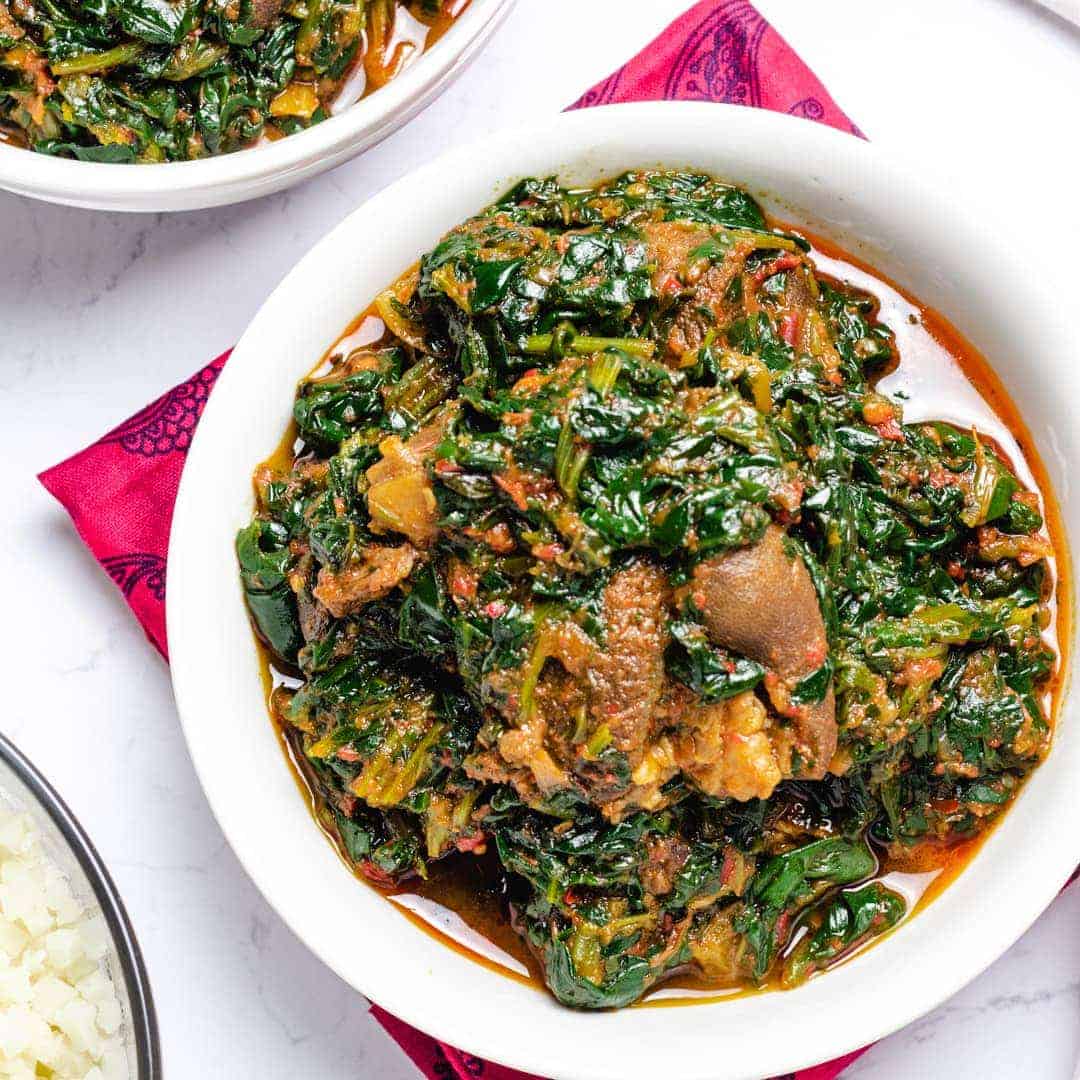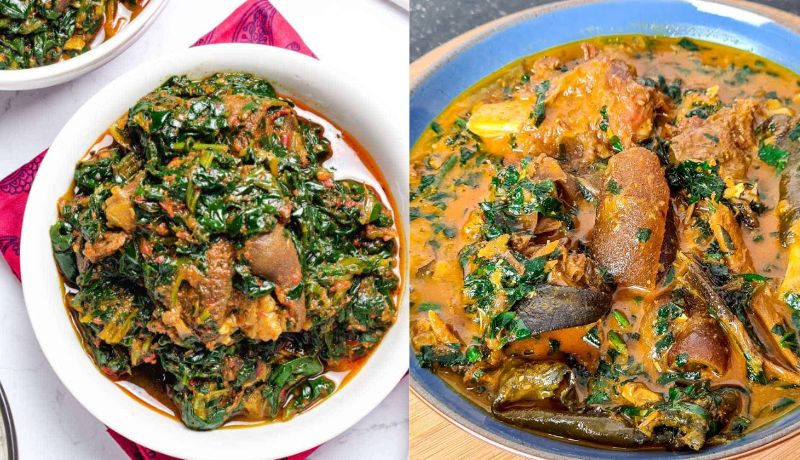Vegetable Soup is both comforting and nutritious, making it the perfect meal. If you’re ready to embrace some serious vegetable soup inspiration, this article is for you! We’re talking about three unique vegetable soup recipes that will fill your kitchen with delicious aromas and nourish your body without breaking a sweat.
Whether you’re looking for veggie-filled options or something with a little extra protein, we have just the thing.
Vegetable Soup Recipe (3 Unique Types)
Vegetable soups are a great way to enjoy a healthy and hearty meal. It’s simple to make and can be customized to your dietary preferences and tastes.
We’ve included three unique recipes below Efo Riro, Ofe Ugwu, and Edikang Ikong, each offering something different for you to try out. Each of these recipes has an emphasis on utilizing fresh vegetables as the main ingredient for a nutrient-packed soup.
No matter what your ideal vegetable soup looks like, you’ll find plenty of options here! So gather up the ingredients from the list below and opt for the delightful flavor of vegetable soups.
Yoruba Vegetable Soup (Efo Riro) Recipe

Yoruba Vegetable soup, also known as Efo Riro, is a classic Nigerian dish for those looking to get creative in the kitchen. It’s a one-pot meal that’s packed with flavor and nutrients that are perfect for lunch or dinner.
Use locust beans, smoked fish or dried fish, and palm oil if you want to prepare the Efo Riro Yoruba way. After the primary ingredients, whatever more you choose to add simply enhances it. To make the vegetable soup, you also need blended pepper.
To make Efo Riro, you’ll need the following ingredients:
- Onions
- Tomatoes
- Scotch bonnet chillies
- Red bell peppers (tatashe)
- Efo Tete (You can use Spinach as a substitute)
- Ponmo
- Dried Fish, e.g Panla
- Assorted meats of your choice (pork, beef, chicken)
- Palm oil
- Seasonings
- Salt
- Locust beans (Iru woro)
- Grounded Crayfish
Preparations
- Pick the vegetable from the stalk and slice it into small sizes
- Rinse the vegetable clean, then drain the water and set aside
- Wash the locust beans
- Chop an onion
- Shred the fish into flakes
- Grind the bell pepper (tatashe) and onions; you can add them to a blender and pulse for a coarse texture
Step 1: Place a pan on medium heat and add a reasonable amount of palm oil, heat for about 3 minutes but ensure you don’t bleach it
Step 2: Add iru woro and chopped onions, then fry for about 2 minutes
Step 3: Pour the blended pepper into the palm oil and stir for about 3 minutes
Step 4: Add the diced ponmo and grounded crayfish and cook for another 3-4 minutes on low to medium heat
Step 5: Add your seasoning and a pinch of salt. (Ensure it is just the right amount)
Step 6: Boil the quantity of water that is enough to cover the vegetable. Once the water is boiled, pour over the vegetable and cover it with a lid for 5 minutes. Then Strain and squeeze out the excess water from the vegetable.
Step 7: Continue cooking the sauce till oil floats on the top, then add your protein (Smoked or Dried Fish) and stir to combine. (You can add a little water to the sauce if it is too dry, but not too much)
Step 8: Add the vegetable to the sauce and stir till all the ingredients are well incorporated.
Step 9: Check for salt and cook for another 3 minutes. Take it off the heat and set it aside.
You can Serve efo riro soup with any swallow of choice or rice.
Igbo Vegetable Soup (Ofe Ugwu) Recipe
The second type of vegetable soup we’ll cover today is Ofe Ugwu, which is an Igbo vegetable soup from Nigeria. Among its three main ingredients, the Ugwu leaf is the star of the show and gives it a unique flavor profile. Here are the necessary ingredients and each step in the preparation process to make this amazing dish:
To make Ofe Ugwu, you’ll need the following ingredients:
- Ugu Leaves
- Palm Oil
- Smoked Fish or Stockfish
- Goat meat
- Achi (a kind of thickener)
- Shaki
- Uziza leaves
- Periwinkle (Nsam in Igbo)
- One bunch of Ugu leaves
- Pepper
- Ogiri
- Palm oil
- Seasoning
- Salt
Step-by-Step Preparation:
Step 1: Boil your goat meat, shaki, and Beef with seasoning and pepper.
Step 2: Add enough water to your pot.
Step 3: Add 2 serving spoons of palm oil; after that, add ogiri, crayfish, and stockfish, then leave to boil.
Step 4: Dissolve the Achi in cold water and add to the soup. (You need to dissolve it in cold water first to avoid lumps), the Achi will thicken as it boils.
Step 5: Add smoked fish, periwinkle, and salt.
Step 6: Lastly, add uziza and ugwu and leave to boil for 2 minutes.
Serve with any swallow of choice.
Now that you have all the steps in place, you can create this delicious Igbo vegetable soup at home.
Calabar Vegetable Soup (Edikang Ikong) Recipe
Calabar vegetable soup, otherwise known as Edikang Ikong, is a delicious and hearty soup with a bold flavor.
Edikang Ikong soup or Edikang Ikong soup can be made in many different ways. As an illustration, some people prefer to include onions, while others prefer to omit them. Pumpkin leaves, water leaves, and a combination of meat are the universal ingredients.
Depending on your preferences, you may use more or less of a specific ingredient, but it’s important to keep in mind that Edikang Ikong isn’t supposed to be watery.
To make Edikang Ikong, you’ll need the following ingredients.
- 1kg beef
- 1 cup of rich stock
- 3 cups of palm oil
- 500g of finely chopped pumpkin leaves,
- 1 onion bulb
- 400g of finely chopped waterleaf or spinach
- 400g dries of fish
- 3 seasoning cubes
- 300g of cleaned and softened stockfish,
- 200g kpomo
- 1.5 cups of grounded crayfish
- Pepper
- Salt to taste
Step 1: Wash all the ingredients thoroughly
Step 2: Season and boil your meat to make your stock
Step 3: When the meat is soft, add the stockfish and pomo and cook for about 3 minutes
Step 4: When you have about one cup of water left in the pot, add the pumpkin leaves and cook for about 3 minutes (Note that this soup doesn’t require a lot of water)
Step 5: Add the waterleaf, crayfish, and palm oil. Then Cook for about 5 minutes
Step 6: Add seasoning, pepper, and salt to taste
Remove from heat and serve hot with your favorite side dish. Enjoy!
How to Compliment and Serve Nigerian Vegetable Soups
No matter what type of vegetable soup you’re making, it’s important to know how to serve and complement it to enhance its flavor. Nigerian vegetable soups are best served with either Eba, Amala, Wheat, Semo, Pounded Yam, or Fufu and can also be served with boiled yams, plantains, rice, or other starchy sides.
Frequently Asked Questions
Still, have questions about making delicious vegetable soup? Don’t worry; we’ve got the answers. Check out the list below of some frequently asked questions about vegetable soup:
Is it possible to freeze the soup?
A: Yes, you can freeze the soup. To do this, prepare the soup as directed and then allow it to cool before transferring it to an airtight container. Place the container in the freezer, and the soup will stay fresh for up to three months. When you’re ready to eat it, just warm it up in the microwave before serving.
Is vegetable soup healthy?
Vegetable soups are generally low in fat and calories, but they are full of vitamins and minerals. Vegetables are an excellent source of fiber and nutrients like calcium and iron. Plus, soups can be very filling, which makes them a great meal choice when trying to lose weight.
Conclusion
Overall, vegetable soups are a great way to get more vegetables into your diet. They are easy to make, healthy, and can be served in many different ways for a variety of flavors and textures. Plus, you can store it in the freezer for up to three months! So why not try making your own vegetable soup today?
